Introduction: In this article, Melissa Davenport Berry continues her series on descendants of the Jamestown settlers, turning again to a descendant of Pocahontas. Melissa is a genealogist who has a blog, AnceStory Archives, and a Facebook group, New England Family Genealogy and History.
Today I continue with my “Jamestown Descendants: Who’s Who” series, returning to the story of the lineage of Catherine Chamber Barnes (1938-2009), a double descendant of John Rolfe and Pocahontas: 10th generation from her father’s line and 11th generation from her mother’s. John and Pocahontas married in Virginia on 5 April 1614.
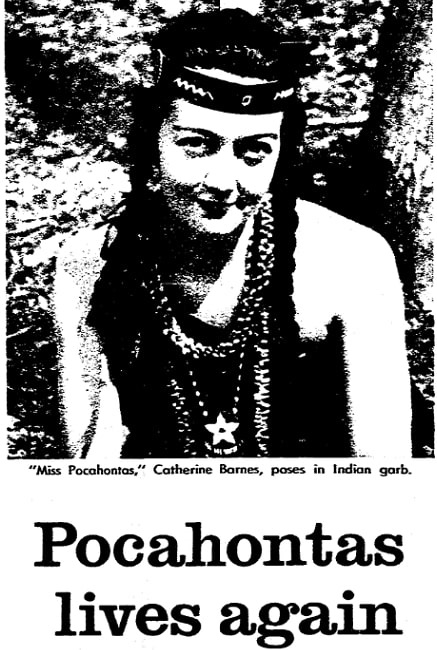
Catherine Barnes’ lineage from her maternal side:
- John Rolfe and Pocahontas, also known by her Christian name “Lady Rebecca”
- Thomas Rolfe and Jane Poythress
- Jane Rolfe and Robert Bolling
- John Bolling and Mary Kennon
- Elizabeth Bowling and William Gay
- William Gay Jr. and Judith Scott
- Edward Scott Gay and Catherine N. Tazewell
- Edward Scott Gay Jr. and Sarah “Sallie” Mahula Ewell
- Louisa Cary Gay and Sidney Goodwin Stubbs
- Louisa Gay Stubbs and William Chambers Barnes
- Catherine Chambers Barnes married William Ralph Stein
To recap: My last story covered Catherine Barnes when she portrayed her ancestor Pocahontas in 1962 for the Jamestown Festival Park’s 350th anniversary celebration marking John Rolfe’s first planting of a tobacco crop, which rescued the Jamestown Colony from economic collapse. See: Jamestown Descendants: Who’s Who, Part 8
As noted in the Virginian-Pilot newspaper article I highlighted in my previous Jamestown article, Rolfe loaded his first shipment of tobacco on the ship Elizabeth. As soon as it got to London, the merchants bought the tobacco up at a good price and ordered all that the colonists could possibly produce.
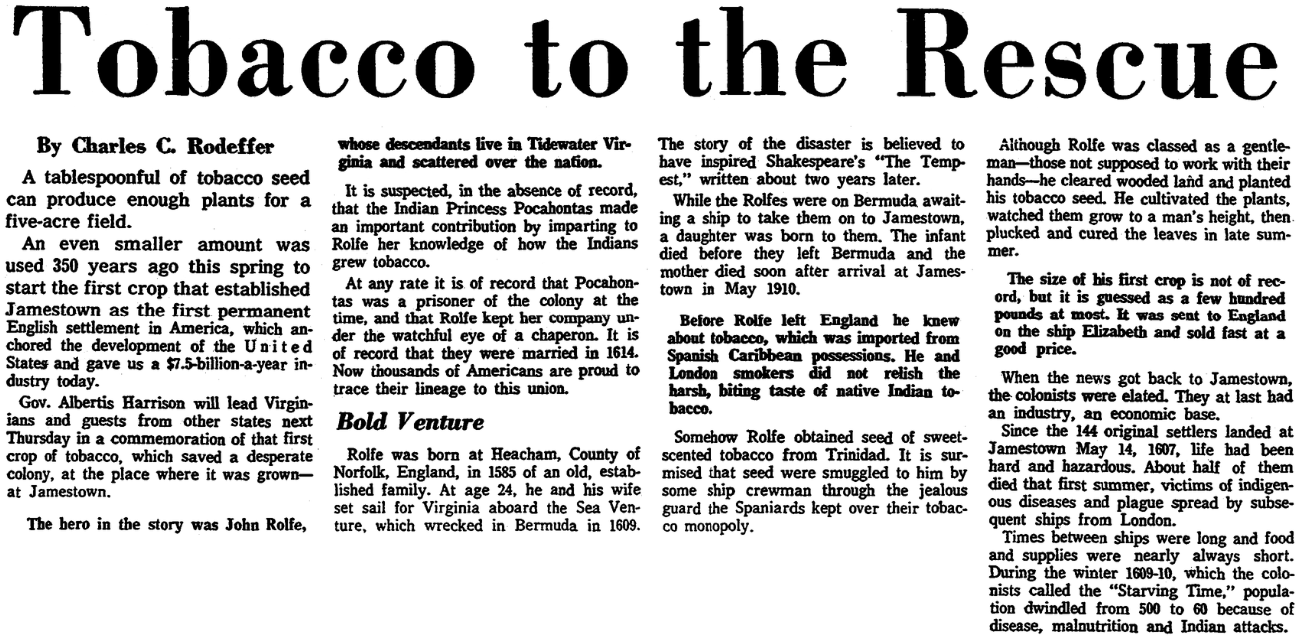
According to this article:
In the 1580s Englishmen had tried to settle at Newfoundland, at Elizabeth’s Island in what is now Massachusetts, at the mouth of the Kennebec River, Maine, and twice on Roanoke Island in North Carolina. All the settlements failed…
Now Jamestown was almost another casualty. And had it not been for John Rolfe’s little tobacco crop, the colony might easily have gone the way of the others and seriously delayed eventual development of this country.
As the tobacco business boomed here are some smoking figures, as reported in the article:
The tobacco business Rolfe started grew to 2,500 pounds by 1616, 20,000 pounds by 1617, 40,000 pounds a year later; and 12 years later it was 1.5 million pounds. Meanwhile, Rolfe improved tobacco by crossing his Trinidad strain with some from Caracas.
Tobacco became such a bonanza that it was grown even in Jamestown’s muddy streets.
It was used as legal tender to pay taxes, preachers, physicians, teachers, and for most every transaction for many years in Virginia.
The article concluded (remember, these figures were current in 1962):
Today some 800,000 families in 21 states grow tobacco worth more than $1 billion a year. Some 17 million Americans earn all or part of their livelihood from tobacco and its industrial complex. The industry yields more than $3 billion a year in federal revenue.
And it all started from a few pinches of almost microscopic seed 350 years ago.
I found an article in the Evening Star which provided some background on the marriage of John Rolfe and Pocahontas, and the many descendants of this couple.
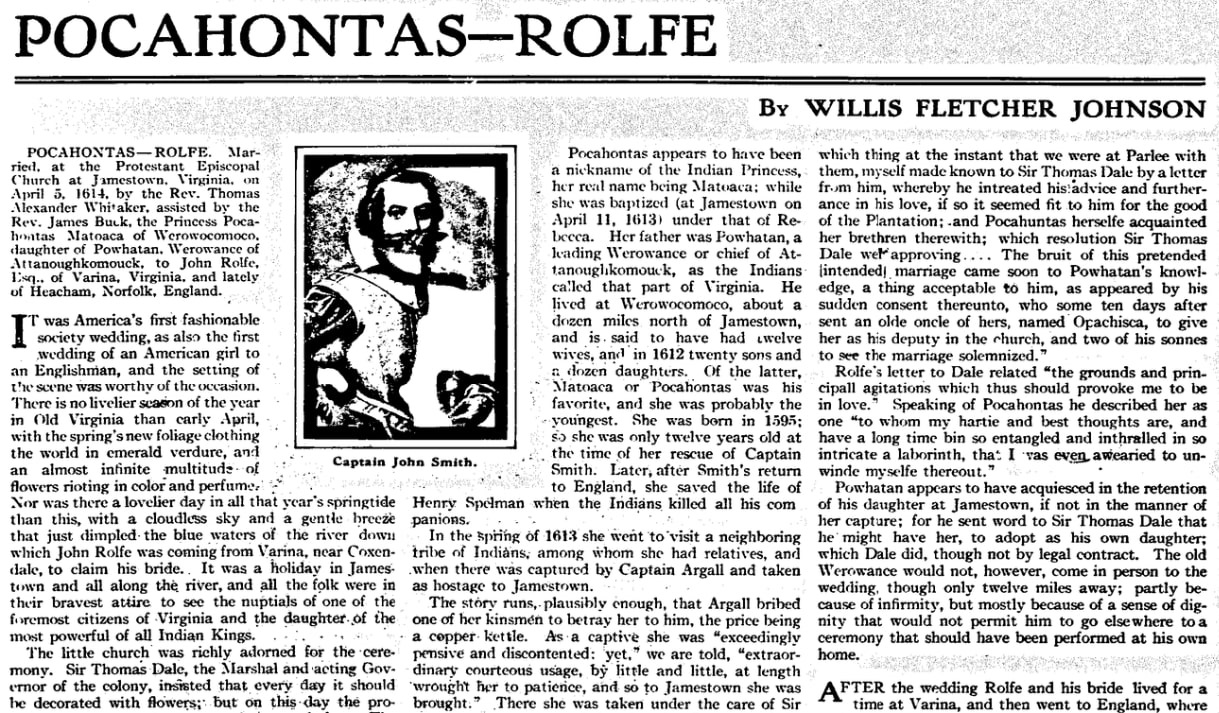
The author, Willis Fletcher Johnson, began his account with this opening paragraph:
It was America’s first fashionable society wedding, as also the first wedding of an American girl to an Englishman, and the setting of the scene was worthy of the occasion. There is no livelier season of the year in Old Virginia than early April, with the spring’s new foliage clothing the world in emerald verdure, and an almost infinite multitude of flowers rioting in color and perfume. Nor was there a lovelier day in all that year’s springtide than this, with a cloudless sky and a gentle breeze that just dimpled the blue waters of the river down which John Rolfe was coming from Varina, near Coxendale, to claim his bride. It was a holiday in Jamestown and all along the river, and all the folk were in their bravest attire to see the nuptials of one of the foremost citizens of Virginia and the daughter of the most powerful of all Indian Kings.
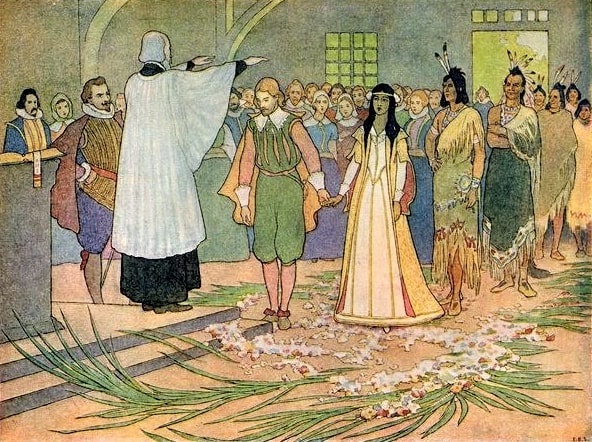
Here is some of the background provided by this article:
After the wedding Rolfe and Pocahontas lived for two years at Varina, a plantation 50 miles from Jamestown that Rolfe named after a strain of Spanish tobacco called Varina. Their only child, a son named Thomas, was born in January 1615. Rolfe took his family to England in the summer of 1616, arriving at the port of Plymouth on 12 June 1616.
Pocahontas was “warmly received” by members of the Rolfe family at Heachman Hall, Norfolk, and was presented at the Court of King James I.
In March of 1617 the family began their voyage back to Virginia, but they only got as far as Gravesend on the Thames River before Pocahontas fell ill. She died at Gravesend, where the record still appears in the parish register:
“1617 March 21. Rebecca Wrolfe, wyffe of Thomas (John) Wrolfe, gentleman, a Virginia lady borne, was buried in the chauncel.”
The article also reported on their descendants:
The descendants of this couple are numerous, and have included many persons of distinction in the public life of the nation. They had only one child, Thomas Rolfe, born in 1615, who married Jane Poythress, of England, and lived on his father’s estate at Varina, at Henricopolis. He in turn had also only one child, Jane Rolfe, who married Colonel Robert Bolling of London, England. Again, in the third generation, there was only one child, John Bolling, who became a Colonel of Virginia troops and a member of the House of Burgesses. He married Mary Kennon, daughter of Dr. Kennon, one of his fellow Burgesses, and they left, in the fourth generation, a son and five daughters, all of whom married and “increased and multiplied.”
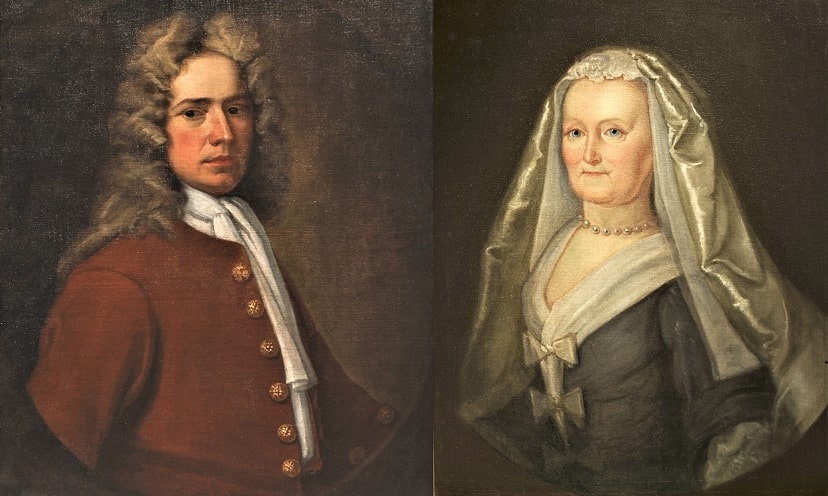
Catherine Barnes, our subject, is descended from one of those five daughters, Elizabeth Bolling, who married William Gay.
The other five children born to John Bolling and Mary Kennon are:
- John Bolling Jr. married Mary Blair, niece of Dr. Blair, who founded William and Mary College
- Jane Bolling married Colonel Richard Randolph, a Burgess, and Treasurer of Virginia
- Mary Bolling married Colonel John Fleming, also a Burgess and Treasurer
- Martha Bolling married Thomas Eldridge
- Anne Bolling married James Murray, who owned “Athol Braes” near Petersburg in Amelia County, Virginia, in what is now Prince George County
Other Jamestown notables in Catherine Barnes’ family tree include James Williamson, William Underwood, John Bolling, William Hatcher, Christopher Newport, William Bassett, Robert Dudley, and Christopher Robinson.
The Jamestowne Society has a list of qualifying ancestors: Jamestowne Society.
Stay tuned for more Jamestown stories!
Note: An online collection of newspapers, such as GenealogyBank’s Historical Newspaper Archives, is not only a great way to learn about the lives of your ancestors – the old newspaper articles also help you understand American history and the times your ancestors lived in.
Note on the header image: a portrait of Pocahontas engraved by Simon van de Passe in 1616. It is the only known representation of her made during her lifetime. Credit: National Portrait Gallery; Wikimedia Commons.
Recent Articles:
